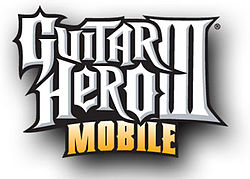Guitar Hero Mobile series
| Guitar Hero Mobile | |
|---|---|

Logo for the first mobile game, Guitar Hero III Mobile
|
|
| Genres | Rhythm |
| Developer(s) | MachineWorks Northwest LLC, Glu Mobile |
| Publisher(s) | Hands-On Mobile |
| Platform of origin | Mobile phone, Windows Mobile |
Guitar Hero Mobile is a series of rhythm video games in the Guitar Hero series, adapting the normal console-based gameplay which uses a guitar-shaped controller to match notes of popular rock music songs to work with the face buttons on advanced mobile phones, including BlackBerry devices and those supporting the Windows Mobile platform. The first three games in the series—Guitar Hero III Mobile, Guitar Hero Backstage Pass, and Guitar Hero World Tour Mobile—were developed by MachineWorks Northwest LLC and published by Hands-On Mobile, while a mobile version of Guitar Hero 5 was developed by Glu Mobile. The series has proven to be popular; the Guitar Hero III Mobile game has been downloaded more than 2 million times, and over 250,000 songs are played each day across the series.
Originally, the Guitar Hero Mobile series was published by Hands-On Mobile and developed by MachineWorks Northwest LLC. For the first game, Guitar Hero III Mobile, Hands-On Mobile received licensing from Activision to port 51 songs, two characters, three venues, and four guitars to the mobile version. The game was originally released on Verizon Wireless, but made available on other cellphone carriers in February 2008. The game was programmed by Robinson Technologies (shortened to RTSoft) in affiliation with MachineWorks Northwest LLC. The game graphics were developed in collaboration with RTSoft and MachineWorks Northwest LLC by Anthem Game Group. The audio was taken from the original audio files used by Activision for Guitar Hero III: Legends of Rock. The audio files were reduced in file size, but remained multichannel; for example, separate channels were used for the guitar track, background instruments and vocals, audience, etc. Each song was reduced in length to two minutes to maintain shorter, "bite-sized" gameplay. To reduce the file size used by the phone, only two songs are stored at any time. Accessing other songs requires them to be downloaded via a cellphone network. A five button setup—like in console versions—was considered, but testing showed the game to be more entertaining with only three buttons. Rapid transitions and simultaneous button presses were included to add difficulty to the gameplay and compensate for the missing buttons.
...
Wikipedia
